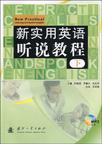新实用英语听说教程(下)
出版时间:2009-4 出版社:国防工业出版社 作者:陈薇薇,罗春红,米玉琴 著 页数:147
前言
教育部颁布的《大学英语教学基本要求》、《高职高专教育英语课程基本要求》(以下统称“两个《基本要求》”)指出,“要重视语言学习的规律,正确处理听、说、读、写、译之间的关系,确保各项语言能力的协调发展。目前要特别注意加强听说技能的培养”。1999年11月,教育部正式批准在全国推行大学英语、高职高专英语口语考试。可见“两个《基本要求》”将学生的听说技能的培养放到了很重要的位置,为各类高等院校组织英语教学和教学改革提供了纲领性文献。 根据“两个《基本要求》”的精神,我们在调研、分析以及问卷调查基础上,组织具有丰富教学经验的教师编写了本套英语听说教程。在坚持“以应用为目的,以实用为准绳”的前提下,强调语言的交际性、真实性、趣味性和实用性;强调练习的多样性和互动性。所选材料具有现代气息,贴近生活实际;设计新颖,图文并茂。本教材打破传统英语教学注重语法、注重学科体系完善的模式,大胆采用项目教学、情景教学的方法,由浅入深,循序渐进,是一套便于记忆、可以灵活使用的听说教材。它适用于非英语专业的本科生、高职高专的学生以及英语爱好者。 本套教材共分上、下两册,每册12个单元,每个单元由8个部分组成。上册是把日常语言和文化礼仪组合在一起进行编写。下册是把社交场合和文化背景组合进行编写。本套教材内容包括:Part I Culture Background 本部分介绍本主题相关的文化背景,诠释单元的主题元素。PartⅡFunctional Language 本部分是语言功能句的学习,针对大学生已经有一定英语基础的特点,每单元的语言功能句覆盖面不止一项,并且列出了常用的功能句和情景句型,目的是让学生熟悉掌握各种句型,并了解如何在不同情景下恰当得体地表达和交流。 PartⅢSample Dialogues 本部分是以一位美国人到中国参观为主线,根据他在中国交友、生活等各种经历,编写了不同情节的对话,充满生活气息,提高学习者的兴趣。 本部分是两人对话和小组交流的组合,是针对第二部分的语言功能句和情景句型分别设计的活动。目的是通过具体的训练,进一步熟练运用所学句型,成功完成交流的任务。PartⅣReproduction 本部分是使用自己的话语进行对话训练,对对话进行复述、排序、接续、创作等。目的是通过形式多样,颇具趣味的对话来提高学生的表达能力,培养创造力和想象力。
内容概要
本套教材共上、下两册,每册12个单元。下册是把社交场合和文化背景组合在一起进行编写,每单元分8部分,分别是Culture Background;Functional Language;Sample Dialogues;Reproduction;Words,Phrases and Sentences;Listening Activities;SpeakingPractice;Reading。《新实用英语听说教程(下)》采用项目教学、情景教学的方法,配套MP3为纯美音录制,更附教师课堂讲授课件,是一套既方便教师教学,又符合学生学习认知规律的优秀的听说教材。 《新实用英语听说教程(下)》适合非英语专业本科生、高职高专学生及英语爱好者选用,尤其适合选作教材。
书籍目录
Introduction of CharactersUnit 1 At the HotelPart Ⅰ Culture BackgroundPart Ⅱ Functional LanguagePart Ⅲ Sample DialoguesDialogue 1Dialogue 2Part Ⅳ ReproductionPart Ⅴ Words,Phrases and Sentences1.Words and Phrases2.Extension3.Useful SentencesPart Ⅵ Listening ActivitiesActivity 1Activity 2Part Ⅶ Speaking Practice1.Making Dialogues2.Speaking English Through Picture3.Related Words and Phrases4.TranslationPart Ⅷ ReadingUnit 2 AttheShopPart Ⅰ Culture BackgroundPart Ⅱ Functional LanguagePart Ⅲ Sample DialoguesDialogue 1Dialogue 2Part Ⅳ ReproductionPart Ⅴ Words,Phrases and Sentences1.Words and Phrases2.Extension3.Useful SentencesPart Ⅵ Listening ActivitiesActivity 1Activity 2Part Ⅶ Speaking Practice1.Making Dialogues2.Speaking English Through Picture3.Related Words and Phrases4.TranslationPart Ⅷ ReadingUnit 3 At the LaundryPart Ⅰ Culture BackgroundPart Ⅱ Functional LanguagePart Ⅲ Sample DialoguesDialogue 1Dialogue 2Part Ⅳ ReproductionPart Ⅴ Words,Phrases and Sentences1.Words and Phrases2.Extension3.Useful SentencesPart Ⅵ Listening ActivitiesActivity 1Activity 2Part Ⅶ Speaking Practice1.Making Dialogues2.Speaking English Through Picture3.Related Words and Phrases4.TranslationPart Ⅷ ReadingUnit 4 At the BarbersPart Ⅰ Culture BackgroundPart Ⅱ Functional LanguagePart Ⅲ SampleDialoguesDialogue 1Dialogue 2Part Ⅳ ReproductionPartVWords,PhrasesandSentences1.WordsandPhrases2.Extension3.UsefulSentencesPart Ⅵ ListeningActivitiesActivity 1Activity 2Part Ⅶ SpeakingPractice1.MakingDialogues2.SpeakingEnglishThroughPicture3.RelatedWordsandPhrases4.TranslationPart Ⅷ ReadingUnit 5 At theBankPart Ⅰ CultureBackgroundPart Ⅱ FunctionalLanguagePart Ⅲ SampleDialoguesDialogue 1Dialogue 2Part Ⅳ ReproductionPart Ⅴ Words,PhrasesandSentences1.Words and Phrases2.Extension3.Useful SentencesPart Ⅵ ListeningActivitiesActivity 1Activity 2Part Ⅶ SpeakingPractice1.Making Dialogues2.Speaking English Through Picture3.Related Words and Phrases4.TranslationPart Ⅷ ReadingUnit6 At the RestaurantPart Ⅰ CultureBackgroundPart Ⅱ FunctionalLanguagePart Ⅲ SampleDialoguesDialogue 1Dialogue 2Part Ⅳ ReproductionPart Ⅴ Words,Phrases and Sentences1.Words and Phrases2.Extension3.Useful SentencesPart Ⅵ ListeningActivitiesActivity 1Activity 2Part Ⅶ Speaking Practice1.Making Dialogues2.Speaking English Through Picture3.Related Words and Phrases4.TranslationPart Ⅷ ReadingUnit 7 At the HospitalPart Ⅰ CultureBackgroundPart Ⅱ FunctionalLanguagePart Ⅲ SampleDialoguesDialogue 1Dialogue 2Part Ⅳ ReproductionPart Ⅴ Words,PhrasesandSentences1.Words and Phrases2.Extension3.Useful SentencesPart Ⅵ ListeningActivitiesActivity 1Activity 2……Unit 9 At the ThreaterUnit 10 At the Olympic StadiumUnit 11 At the Post OfficeUnit 12 At the Customs答案Unit1Unit2Unit3Unit4Unit5Unit6Unit7Unit8Unit9Unit10Unit11Unit12
章节摘录
Now you know the sample dialogues quite well. Why dont you try to make some-thing like them. (1) Act out the dialogues in pairs. Dont look at the book and read. Put the bookaway and speak from memory. It doesnt matter if you make a few mistakes. When youforget a point, say something else that means almost the same thing. Or just leave thepoint alone and go on. (2) The following is an example of how you can talk about what happens betweenPreston and Laundryman at the laundry. Preston went to the laundry with the suit, a woolen sweater and a white shirt. Thelaundryman told him the ways of washing them. white shirt should be washed in waterwith hands; suit and woolen sweater dry-cleaned in special machine. Preston thoughtthe dry-cleaning was a bit expensive, and said his wife always had them washed togetherin water. The laundryman said the clothes would be either shrink or fade; especially thedark-colored clothes would fade away gradually. Preston agreed with him. Then he consulted the laundryman what were the neces-sary things he should pay attention to when doing washing. The laundryman told himthe simplest points, divide the clothes by colors; wash them in cold water. As to thestains such as sugar, coffee, let the dry cleaner know and manage. Preston thought theinformation was useful and he would remember it. When paying for the laundry, Pres-ton still thought it was expensive; the laundryman said the cost was worthy for it couldprovide good washing quality. He told Preston that the clothes could be done on Friday.
编辑推荐
采用项目数学、情景教学的方法,强调教学的多样性和互动性。 mp3为纯美音制,附赠教师授课课件。 既方便教师教学,又符合学生学习认识规律。
图书封面
评论、评分、阅读与下载
用户评论 (总计0条)
推荐图书
- ASP.NET 3.5实例精通
- 郑光中建筑速写
- 中国名花鉴赏
- 国人必知的2300个绘画常识(中国卷)
- 国人必知的2300个绘画常识(西方卷)
- 国人必知的2300个文学常识
- 国人必知的2300个文学常识(西方卷)
- 国人必知的2300个音乐常识(西方卷)
- 昆明城中村改造实务指引与风险控制
- 桥梁与都市国际论坛·重庆2009论文集
- 机动车安全技术检验人员考试参考题集2008版
- 员工安全生产必读丛书安全作业必读
- 深井硬岩大规模开采理论与技术
- 煤矿总工程师工作手册
- 海南天然橡胶产业发展研究
- 橡胶制品配方
- 饭店管理概论
- 服务营销
- 商品学
- 市场营销心理学
- 药用高分子材料
- Windows Vista实用教程
- 大学计算机基础
- 现代工程制图及计算机辅助绘图
- PRO/ENGINEER中文野火版4.0工程图教程
相关图书
- 西点的10堂领导课
- 教师专业发展的新路径地方高师院校教师教育专业学生新三手能力培养研究与实践
- 小故事大道理(全四卷)
- 新编大学生体育与健康
- 魔鬼凯恩斯
- 探索经济繁荣
- 金融理财原理(上)
- 金融理财原理(下)
- 周易全解(全四册)
- 中华处世经典(全四册)
- 社会城市
- 中国文学研究第十三辑
- 比尔·盖茨管理日志
- 外国美学
- 哈特曼-考克斯-当代世界建筑经典精选
- 巴顿·迈尔斯
- 特里·法雷尔
- 菲利浦·考克斯及其建筑设计事务所
- 阿勒普联合设计事务所
- SOM建筑设计事务所-当代世界建筑经典精选
- 赫尔穆特.扬及墨菲-扬事务所-当代世界建筑经典精选
- 彼得·艾森曼
- 现代电镀技术
- 农村电气化与节约用电
- 供电企业员工安全手册
